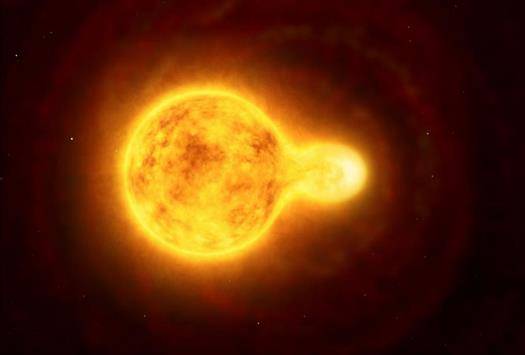
Oh, snap. A powerful new array of telescopes took its first pictures, the European Southern Observatory announced today. "First light" photos aren't always scientifically interesting, but in the years to come, the Next-Generation Transit Survey will take images of planets orbiting other suns, seeking worlds that look a bit like Earth.

The astronomer who discovered the size of this star says it's shaped like a peanut, butwe disagree; that one "lobe" is much too large. Perhaps that's because the larger star is, in fact, one of the 10 largest stars ever discovered. Its diameter is 1,315 times that of Earth's sun.


Inside the European Southern Observatory's Atacama Pathfinder Experiment (APEX) telescope in Chile, there's a submillimetre-wavelength camera perfectly tuned to peer through the clouds of interstellar dust and gas that obscure our view of what's going on elsewhere in the universe. Fortunately for us, the camera is also good at picking up the faint glow given off by those very same grains of dust, at wavelengths too long for human eyes to see. The result: images like this one a "fiery ribbon" (that's how astronomers are describing it) stretching across a segment of the Orion Nebula some 1,350 light-years away.

In this picture, you are looking at a central concentration of ancient stars in the bulging part of our galaxy. The bulge is full of dust, gas and most of the stars in the Milky Way, which makes it hard to study - astronomers have to suss out stars from crowded, dusty zones and figure out how far they are from us. This new image catalogs 84 million of them, which is 10 times the number of stars cataloged in any previous study.

When it comes to enduring legacies, supernovae have little competition in the universe. What you are looking at above is the Pencil Nebula (though its appearance is sometimes compared to a witch's broomstick) as captured in a new image by the Wide Field Imager at the European Southern Observatory's La Silla Observatory in Chile. From our vantage point on Earth, it is still noticeably moving across the night sky even though it is something like 8,000 light-years away. All this from a star that exploded 11,000 years ago.

Galaxy building theory says there are stars and there are stage hands. The bright, shining galaxies filled with stars, the theory goes, took star-building gas from somewhere else, but we couldn't find exactly where the help came from. Now astronomers have likely found that source; starless "dark galaxies" that fed others early in the history of the universe have been seen.














